Thomas Howard, 4th Duke of Norfolk
Thomas Howard, 4th Duke of Norfolk, KG (10 March 1536 – 2 June 1572) was an English nobleman and politician. Although from a family with strong Catholic leanings, he was raised a Protestant. He was a second cousin of Queen Elizabeth I through her maternal grandmother, and held many high offices during her reign.
Thomas Howard | |
|---|---|
| Duke of Norfolk | |
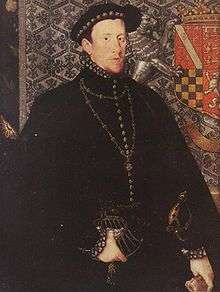 | |
| Born | 10 March 1536 |
| Died | 2 June 1572 (aged 36) Tower Hill , London, England |
| Noble family | Howard |
| Spouse(s) | Mary FitzAlan Margaret Audley Elizabeth Leyburne |
| Issue
Philip Howard, 20th Earl of Arundel Thomas Howard, 1st Earl of Suffolk Lord William Howard Lady Elizabeth Howard Lady Margaret Howard | |
| Father | Henry Howard, Earl of Surrey |
| Mother | Frances de Vere |
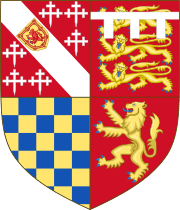
Norfolk was the son of the poet, soldier and politician Henry Howard, Earl of Surrey. He commissioned Thomas Tallis, probably in 1567, to compose his renowned motet in forty voice-parts, Spem in alium.
He was executed for his role in the Ridolfi Plot.
Early life, family, and religion
Norfolk was taught as a child by John Foxe, the Protestant martyrologist,[1] who remained a lifelong recipient of Norfolk's patronage. His father predeceased his grandfather, so Norfolk inherited the Dukedom of Norfolk upon the death of his grandfather, Thomas Howard, 3rd Duke of Norfolk in 1554.
He was a second cousin of Queen Elizabeth I through her maternal grandmother, Lady Elizabeth Howard, and he was trusted with public office despite his family's history and leanings towards Catholicism.
Career
While still young, Norfolk was Earl Marshal of England and Queen's Lieutenant in the North. From February to July 1560, Norfolk was commander of the English army in Scotland in support of the Lords of the Congregation opposing Mary of Guise. He negotiated the February 1560 Treaty of Berwick by which the Congregation invited English assistance,[2] and after the Treaty of Edinburgh was signed in July of that year he was able to return to Court.[1]
Norfolk was the Principal of the commission at York in 1568 to hear evidence against Mary, Queen of Scots presented by Regent Moray, including the casket letters.[3]
Legal troubles and execution
Having married and lost three wives by 1567, and despite having presided at the York commission, Norfolk schemed to marry Mary, Queen of Scots. William Maitland of Lethington favoured the proposed union, and Mary herself consented to it, but Norfolk was unwilling to take up arms. He was briefly involved in the Northern Rebellion in an attempt to free and marry Mary, and Elizabeth ordered his arrest for this in October 1569. He was imprisoned for nine months.[1] Following his release in August 1570, and after some hesitation, he participated in the Ridolfi plot with King Philip II of Spain to put Mary on the English throne and restore Catholicism in England. The plot was revealed to the queen's minister Lord Burghley,[1] and after a trial in January 1572, in which he was found guilty unanimously, Norfolk was executed for treason in Tower Hill, London, in June.[4][5] He is buried at the Church of St Peter ad Vincula within the walls of the Tower of London.
Norfolk's lands and titles were forfeit, although much of the estate was later restored to his sons. The title of Duke of Norfolk was restored, four generations later, to his great-great-grandson Thomas Howard.
Marriages and issue
First wife
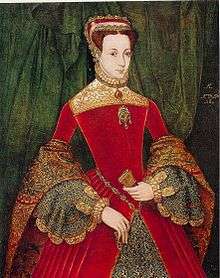
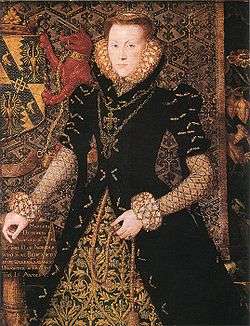
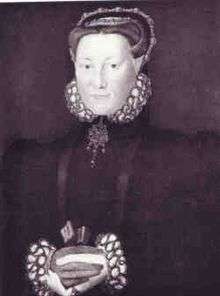
Thomas Howard's first wife was Mary FitzAlan, daughter of Henry FitzAlan, 19th Earl of Arundel. She died after a year of marriage, having given birth to a son, who, on the death of his grandfather, inherited the Arundel title and estates:
- Philip Howard (28 June 1557 – 19 October 1595), who became the 20th Earl of Arundel.
It is from this marriage that modern Dukes of Norfolk derive their surname of 'FitzAlan-Howard' and their seat in Arundel. Though her funeral effigy is found at Framlingham church, Mary FitzAlan was not buried there but first at the church of St. Clement Danes, Temple Bar and then, under the direction of her grandson's will, at Arundel.
Second wife
Norfolk next married another heiress, Margaret Audley,[6] widow of Sir Henry Dudley and daughter of Thomas Audley, 1st Baron Audley of Walden. Margaret's children by her marriage to Norfolk were:
- Thomas Howard, 1st Earl of Suffolk;
- Lord William Howard, ancestor of the Earls of Carlisle;
- Lady Elizabeth Howard (died in childhood);
- Lady Margaret Howard[7]
Margaret Audley Howard's tomb effigy is found at St Michael the Archangel, Framlingham.[8]
Third wife
After Margaret's death in 1563, Norfolk married Elizabeth Leyburne (1536 – 4 September 1567), widow of Thomas Dacre, 4th Baron Dacre of Gillesland and daughter of Sir James Leyburn.
Norfolk's three sons by his first two wives, Philip, Thomas, and William, married, respectively, Anne, Margaret, and Elizabeth Dacre. The Dacre sisters were the daughters of Elizabeth Leyburne by her marriage to Thomas Dacre and were, thereby, stepsisters to Norfolk's sons.
Attempted fourth marriage
After Norfolk's third wife's death in 1567, Mary, Queen of Scots fled to England in 1568 and was imprisoned by Queen Elizabeth. Thomas Howard was suggested as a husband for her as he was a cousin to Queen Elizabeth and the wealthiest landowner in the country. Together they would have a strong claim on England's throne as Mary was also Elizabeth's cousin. This suited Norfolk as he was ambitious and felt Elizabeth consistently undervalued him. Therefore, Norfolk supported the Northern Rebellion in 1569 in an effort to free and marry Mary, Queen of Scots. It is still debated whether this plot actually planned to overthrow Elizabeth or even if Mary knew about it. Howard soon lost his nerve and the plan failed, but he made another effort to marry Mary in 1571 as part of the Ridolfi Plot. This plot planned to murder Elizabeth and free Mary. She would then marry Howard so that they could take the throne. Elizabeth's government discovered the plot and Howard's servants betrayed him under torture. Norfolk was imprisoned by Queen Elizabeth and put on trial in January 1572. He was found guilty unanimously, and beheaded on Tower Hill, London, in June.[9]
Depictions
- Thomas Howard appears as a character in the Philippa Gregory novels The Virgin's Lover and The Other Queen, and in the novel I, Elizabeth by Rosalind Miles.
- A highly fictionalized version of the 4th Duke of Norfolk appears as a villain, played by Christopher Eccleston, in the 1998 film Elizabeth.
- Another version of the Duke is in the BBC mini-series The Virgin Queen, played by Kevin McKidd.
- In the Channel 4 documentary Elizabeth (2000) presented by David Starkey, the Duke is portrayed by actor John Gully.
Ancestry
| Ancestors of Thomas Howard, 4th Duke of Norfolk | |||||||||||||||||||||||||||||||||||||||||||||||||||||||||||||||||||||||||||||||||||||||||||||||||||||||||||||||||||||||||||||||||||||||||||||||||||||||||||||||||||||||||||||||||||||||||||||||||||||||||||||||||||||||||||||||||||||||||||||||||||||||||||||||||||||||||||||||||||||||||
|---|---|---|---|---|---|---|---|---|---|---|---|---|---|---|---|---|---|---|---|---|---|---|---|---|---|---|---|---|---|---|---|---|---|---|---|---|---|---|---|---|---|---|---|---|---|---|---|---|---|---|---|---|---|---|---|---|---|---|---|---|---|---|---|---|---|---|---|---|---|---|---|---|---|---|---|---|---|---|---|---|---|---|---|---|---|---|---|---|---|---|---|---|---|---|---|---|---|---|---|---|---|---|---|---|---|---|---|---|---|---|---|---|---|---|---|---|---|---|---|---|---|---|---|---|---|---|---|---|---|---|---|---|---|---|---|---|---|---|---|---|---|---|---|---|---|---|---|---|---|---|---|---|---|---|---|---|---|---|---|---|---|---|---|---|---|---|---|---|---|---|---|---|---|---|---|---|---|---|---|---|---|---|---|---|---|---|---|---|---|---|---|---|---|---|---|---|---|---|---|---|---|---|---|---|---|---|---|---|---|---|---|---|---|---|---|---|---|---|---|---|---|---|---|---|---|---|---|---|---|---|---|---|---|---|---|---|---|---|---|---|---|---|---|---|---|---|---|---|---|---|---|---|---|---|---|---|---|---|---|---|---|---|---|---|---|---|---|---|---|---|---|---|---|---|---|---|---|---|---|---|---|
| |||||||||||||||||||||||||||||||||||||||||||||||||||||||||||||||||||||||||||||||||||||||||||||||||||||||||||||||||||||||||||||||||||||||||||||||||||||||||||||||||||||||||||||||||||||||||||||||||||||||||||||||||||||||||||||||||||||||||||||||||||||||||||||||||||||||||||||||||||||||||
See also
- Dukes of Norfolk family tree
- John George Howard, a Toronto architect who claims to be related to the Duke.
References
- Chisholm, Hugh, ed. (1911). . Encyclopædia Britannica. 19 (11th ed.). Cambridge University Press. p. 744.
- Calendar of State Papers Scotland, vol. 1 (1898), 323, 440.
- HMC: Manuscripts of the Earl of Salisbury at Hatfield, vol.1 (1883), p. 461.
- Jardine, David. Criminal Trials, Supplying Copious Illustrations of the Important Periods of English History During the Reigns of Queen Elizabeth and James I.: To which is Added a Narrative of the Gunpowder Plot, with Historical Prefaces and Notes, Volume 1, pp. 121-245 (Nattali and Bond, 1847).
- Bacon, Matthew et al. A New Abridgment of the Law with Large Additions and Corrections, Volume 9, p. 399 (T. Davis, 1846).
- "Margaret Howard", National Portrait Gallery
- http://www.geni.com/people/Margaret-Howard/6000000000151561135
- "Churchmouse: Framlingham, Suffolk. Church of St. Michael the Archangel". Homepage.ntlworld.com. 2 May 2000. Archived from the original on 9 March 2012. Retrieved 7 September 2012.
- Hodder Education History for Edexcel: Early Elizabethan England
Further reading
- Edwards, Francis (1968). The marvellous chance: Thomas Howard, Fourth Duke of Norfolk, and the Ridolphi plot, 1570-1572. ISBN 0-246-64474-5.CS1 maint: ref=harv (link)
- "Murdin, William : Collection of State Papers, 1571-1596". London. 1759.CS1 maint: ref=harv (link) papers from Norfolk's treason trial 1568–1572.
- Williams, Neville (1965). Thomas Howard, Fourth duke of Norfolk. ASIN B0007DRE5Y.
- William Cooke Taylor, ed. (2005). Thomas Howard: Fourth Duke of Norfolk. The Benedictine Brethren of Glendalough. ISBN 1-4254-6159-X.CS1 maint: ref=harv (link)
- . Dictionary of National Biography. London: Smith, Elder & Co. 1885–1900.
| Political offices | ||
|---|---|---|
| Preceded by The Duke of Norfolk |
Earl Marshal 1554–1572 |
Succeeded by The Earl of Shrewsbury |
| Preceded by The Earl of Sussex |
Lord Lieutenant of Norfolk 1559–1572 |
Succeeded by Unknown |
| Peerage of England | ||
| Preceded by Thomas Howard |
Duke of Norfolk 3rd creation 1554–1572 |
Vacant Title next held by Thomas Howard |
| Earl of Surrey 3rd creation 1554–1572 |
Vacant Title next held by Thomas Howard | |
| Baron Mowbray 1554–1572 |
Succeeded by Philip Howard | |